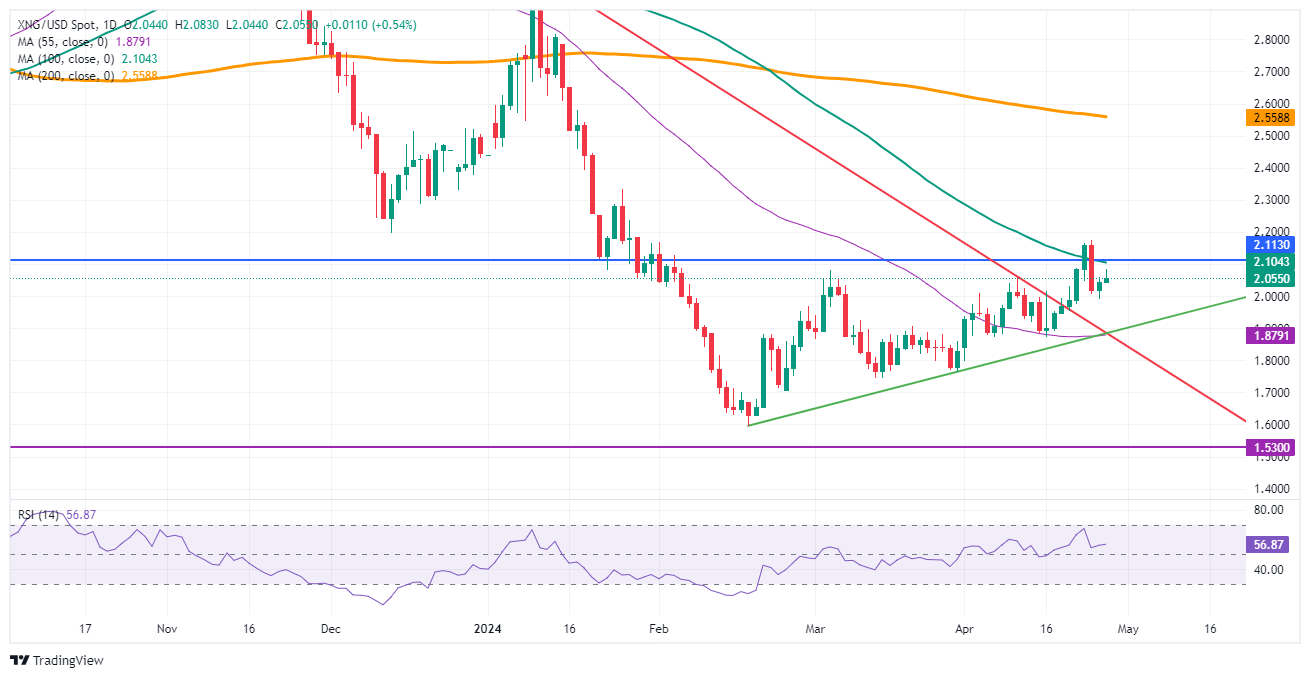- Analytics
- News and Tools
- Market News
- Natural Gas faces upside pressure as European traders prepare for next heating season
Natural Gas faces upside pressure as European traders prepare for next heating season
- Natural Gas price holds ground above $2.00 on Friday.
- Gas prices are likely to tick up as European traders start to prepare for the next winter season.
- The US Dollar Index falls back to the 105.50 region ahead of the US PCE release.
Natural Gas (XNG/USD) prices are holding ground above $2.00 on Friday after a brief dip earlier this week. Gas prices are quickly recovering as mainland Europe is gearing up for the next heating season, with traders starting to negotiate contracts in order to refuel ahead of next winter. Even though European Gas reserves are still at 61%, traders are issuing concerns that the volume of pre-agreed contracts is too little to get strategic reserves back to their near-full levels seen last September, which means more short-term and more expensive handling could occur.
Meanwhile, the US Dollar Index (DXY), which tracks the US Dollar’s value against six major currencies, falls further to the 105.50 region. The devaluation of the Greenback comes after the preliminary US Purchasing Managers Index (PMI) for April, for both manufacturing and services sectors, did not support US exceptionalism further. Thursday’s US Gross Domestic Product for the first quarter release even looks to show the US economy is in stagflation, although that still needs to be confirmed by more numbers and data like the Personal Consumption Expenditure (PCE) release on Friday.
Natural Gas is trading at $2.06 per MMBtu at the time of writing.
Natural Gas news and market movers: Europe gets ready
- The UK is building Europe’s biggest Liquified Natural Gas (LNG) storage, which will be operational in 2025.
- Bloomberg data shows that Qatar is the main deliverer for European Gas, filling in the gap from Russia.
- TotalEnergies SE has reported a smaller-than-expected drop in its first-quarter profit, with elevated Oil prices offsetting the recent crash in Gas prices.
Natural Gas Technical Analysis: Supply questionable
Natural Gas could be entering in a rather steady uptrend, with the demand side from mainland Europe and the UK starting to take in deliveries for restocking ahead of this year’s fall and winter. Subsequently, continuous demand will be present during the spring and summer periods. Meanwhile, on the supply side, Norway and the US have had substantial delivery issues due to unforeseen maintenance and outages in certain LNG facilities. Any further disruptions could trigger a shot higher, with Gas prices heading to $2.50 over the summer.
On the upside, the blue line at $2.11, the 2023 low, and the 100-day Simple Moving Average (SMA) at $2.10 are acting as a resistance. Further up, the next level to watch is the January 25 high at $2.33.
On the other side, the $2.00 handle has worked as nearby support for now. Further down, a trifecta of support is formed at $1.88, with the ascending and descending trend lines crossing and the 55-day SMA. Should that level break, expect a quick downward movement to the year-to-date low at $1.60.
Natural Gas: Daily Chart
Natural Gas FAQs
Supply and demand dynamics are a key factor influencing Natural Gas prices, and are themselves influenced by global economic growth, industrial activity, population growth, production levels, and inventories. The weather impacts Natural Gas prices because more Gas is used during cold winters and hot summers for heating and cooling. Competition from other energy sources impacts prices as consumers may switch to cheaper sources. Geopolitical events are factors as exemplified by the war in Ukraine. Government policies relating to extraction, transportation, and environmental issues also impact prices.
The main economic release influencing Natural Gas prices is the weekly inventory bulletin from the Energy Information Administration (EIA), a US government agency that produces US gas market data. The EIA Gas bulletin usually comes out on Thursday at 14:30 GMT, a day after the EIA publishes its weekly Oil bulletin. Economic data from large consumers of Natural Gas can impact supply and demand, the largest of which include China, Germany and Japan. Natural Gas is primarily priced and traded in US Dollars, thus economic releases impacting the US Dollar are also factors.
The US Dollar is the world’s reserve currency and most commodities, including Natural Gas are priced and traded on international markets in US Dollars. As such, the value of the US Dollar is a factor in the price of Natural Gas, because if the Dollar strengthens it means less Dollars are required to buy the same volume of Gas (the price falls), and vice versa if USD strengthens.
© 2000-2024. All rights reserved.
This site is managed by Teletrade D.J. LLC 2351 LLC 2022 (Euro House, Richmond Hill Road, Kingstown, VC0100, St. Vincent and the Grenadines).
The information on this website is for informational purposes only and does not constitute any investment advice.
The company does not serve or provide services to customers who are residents of the US, Canada, Iran, The Democratic People's Republic of Korea, Yemen and FATF blacklisted countries.
Making transactions on financial markets with marginal financial instruments opens up wide possibilities and allows investors who are willing to take risks to earn high profits, carrying a potentially high risk of losses at the same time. Therefore you should responsibly approach the issue of choosing the appropriate investment strategy, taking the available resources into account, before starting trading.
Use of the information: full or partial use of materials from this website must always be referenced to TeleTrade as the source of information. Use of the materials on the Internet must be accompanied by a hyperlink to teletrade.org. Automatic import of materials and information from this website is prohibited.
Please contact our PR department if you have any questions or need assistance at pr@teletrade.global.
















